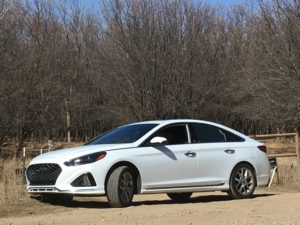
Noticeably firmer in suspension with less body roll, the 2018 Hyundai Sonata has added an 8-speed automatic transmission to its turbocharged engine in an effort to move upward in the always crowded midsize sedan market.
Hyundai in 1998 drew attention by unwrapping a 10-year/100,000-mile powertrain warranty and over the years since has built a satisfied customer base with high fuel-mileage readings and somewhat low-side sticker prices.
The Sonata, though, like every other midsize sedan except for the Toyota Camry, has suffered a sales decline in recent months. Two-month sales totals for 2018 are Toyota Camry 55,503; Nissan Altima 39,888; Honda Accord 37,430; Ford Fusion 27,073; Chevrolet Malibu 19,443; Hyundai Sonata 12,727; Kia Optima 11,600; Subaru Legacy 6,607; VW Passat 5,470; Mazda6 3,798; Buick Regal 2,896.
In an age of affordable gasoline prices, large numbers of SUVs and crossovers have become the choice of onetime midsize car consumers.
The Sonata nine years ago (2009) was a standout when it unveiled a sleek, “fluidic sculpture” exterior. Other makes reacted and soon most of the midsize bunch was busy in a shuffle of restyles and refreshes.
For 2018, in an effort to regain lost market share, Hyundai has enlarged the Sonata grille, added sporty lines to a sloped hood, redesigned the infotainment center stack and went to the 8-speed automatic transmission for its turbocharged engine. A cheaper non-turbo base engine is tied to a 6-speed automatic.
The Limited model I drove performs with a turbocharged, 245-horsepower, 2.0-liter, 4-cylinder engine and the 8-speed, which is with paddleshifters and can be enhanced with Sport mode for quicker shifts and better throttle response. Even with a bit of low-end lag and the fact it’s not as quick as some competitive small turbos, it performs much more satisfactorily than with the 2.4-liter naturally aspirated base power.
In an even split of city/highway maneuvers, the Sonata averaged 26.4 miles per gallon. Its EPA estimate is 23/32 mpg.
The interior is roomy and offers good visibility. Front seats are very supportive and there is plenty of legroom in the rear-seating area. A good-sized trunk provides 16.3 cubic feet of space.
Sized very closely to the Volkswagen Passat, the Sonata rides on a wheelbase of 110.4 inches, is 191.1 inches in overall length and its curb weight is just over 3,500 pounds. Tires are Michelin 235/45R 18; sport-tuned suspensions are front struts and rear multilink. The Korean-based sedan is assembled in Montgomery, Ala.
Prices begin around $23,000 for the least-equipped Sonata. Also among the Sonata’s lineup are an Eco version with 1.6-liter turbo and 7-speed twin-clutch automatic, and a hybrid and plug-in hybrid.
The Limited model, finished in a sparkly quartz white pearl, carried a sticker price of $33,460, including automatic emergency braking, lane-keeping assist, blind-spot detection and rear cross-traffic alert.
Among other amenities are automatic high-beam assist, rearview camera, smart cruise, stop/start capability, sunroof and rear side window sunshades, leather seats heated and cooled in front, heated steering wheel, 8-inch touchscreen navigation, Infinity audio, Apple CarPlay and Android auto integration.
For those asking whether the Sonata might sometime offer all-wheel drive, Hyundai says “probably not.”